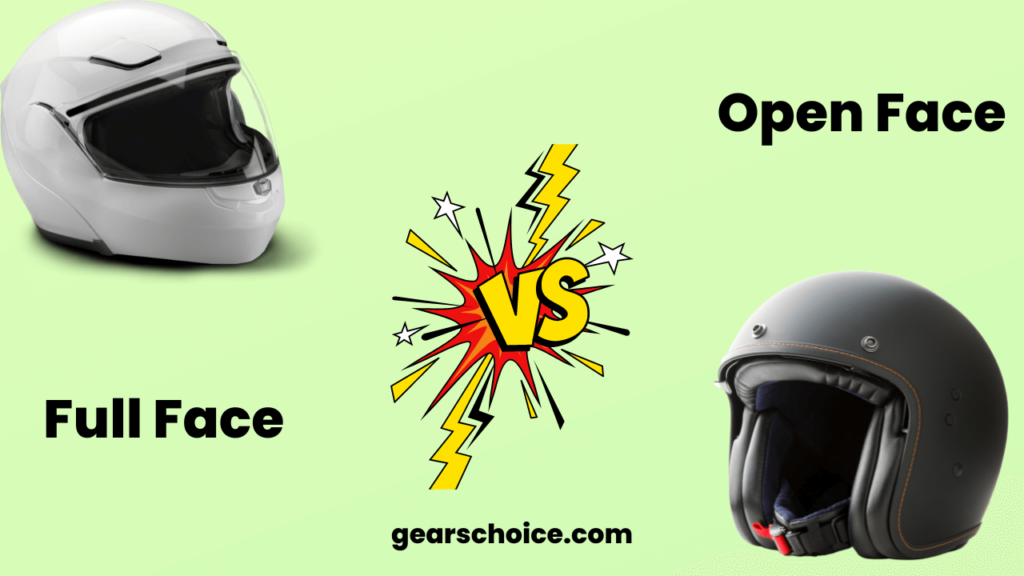Full Face Vs Open Face Helmet – What To Buy?
Everyone who owns a motorcycle wants to ride with the wind blowing through their hair on a hot summer evening.
This is not the only thing that makes owning a bike so great, but it’s what everyone says.
They forget to tell you that they won’t need a helmet because their hair won’t catch on fire when the wind blows.
Some riders use open-faced helmets to keep the balance between freedom and safety well balanced.
Open-face helmets are not a good choice at all. They’re the worst choice because they are the most dangerous.
I’ll let you know why in the following article.

Overview Of Full-Face Vs Open Face Helmet
Open face helmets are less safe compared to full-face helmets. Some riders mistakenly believe that open face helmets offer better protection, but that’s not the case.
Open face helmets provide less coverage, leaving your face exposed in an accident.
When it comes to cost, there’s a common misconception that open face helmets are cheaper.
In reality, full-face helmets can range from $25 to $30, while open face helmets often cost more, typically between $50 and $60.
Another important factor to consider is protection. Open face helmets have smaller vents and fewer protective features, making them less effective at safeguarding your head.
This means they are generally less durable and may not offer the same level of safety as full-face helmets.
The advantages of an open face helmet
- Better Airflow: Open face helmets provide excellent airflow, helping keep your head cool, especially on hot days. This makes long rides more comfortable by reducing heat build-up.
- Comfort and Convenience: These helmets are generally lighter and allow easy access to your face, like scratching your nose or taking a quick drink. They are also more comfortable to wear for extended periods.
- Enhanced Visibility: Open face helmets provide a wider field of view, making it easier to see your surroundings. This can be particularly useful when riding in groups or touring with friends.
- Communication: It’s easier to talk to others or use communication devices without the restriction of a full-face helmet. You can also see your own face if you’re using a mirror or camera for vlogging.
The disadvantages of an open face helmet
- Less Protection: Since an open face helmet doesn’t cover your entire head, it leaves your face exposed to potential injuries. This can be especially dangerous in the event of a crash.
- Reduced Awareness: While it provides a wider field of view, the lack of full coverage can make you less aware of your surroundings due to wind noise and distractions.
- Lower Safety: Open face helmets generally offer less protection against impacts and are more vulnerable to flying debris or bugs hitting your face.
The advantage of a full-face helmet
- Maximum Protection: Full-face helmets offer the highest level of protection, covering your entire head, including your face, chin, and neck. They shield you from impacts, flying debris, and even harsh weather conditions.
- Enhanced Safety: These helmets are designed to protect your eyes, ears, and face from potential injuries. They also provide better protection in high-speed accidents.
- Noise Reduction: Full-face helmets reduce wind and road noise, which can help you focus better on the road and reduce fatigue during long rides.
- Weather Protection: These helmets are great for riding in all weather conditions, as they protect you from rain, wind, and cold.
The disadvantages of a full-face helmet
- Reduced Comfort: Full-face helmets can feel bulky and heavy, especially during long rides. They can also make it harder to communicate with others or hear surrounding sounds clearly.
- Limited Vision: The design of a full-face helmet can slightly restrict your field of view, making it more challenging to see your surroundings.
- Higher Cost: Full-face helmets are generally more expensive due to their advanced protection features and materials.
- Inconvenience: It can be cumbersome to remove a full-face helmet every time you want to drink water, talk, or make quick adjustments while on the road.
The Intermediate: A Modular Helmet
Modular helmets are incredibly versatile because they can be worn both closed, like a full-face helmet, or open, like an open face helmet.
This flexibility allows riders to choose their preferred style based on comfort and safety needs.
When worn closed, modular helmets provide the protection of a full-face helmet, shielding your head and face from impacts.
When worn open, they offer better airflow and visibility, making them more comfortable in warm weather or during short rides.
Modular helmets are ideal for riders who want the option to switch between styles without changing helmets.
They provide a balance between safety and convenience, making them a popular choice for various riding conditions.
Conclusion
A closed face helmet has more padding than an open face helmet. This is because there is less area that is exposed to impact.
But, it also means that there is less space to fit your head inside the helmet, which is why it is important to make sure that your head is comfortably fitted into the helmet.
The key to a good answer is to explain what you did. The first thing that I noticed was that the fabric was not soft enough to keep me warm in the winter and cool in the summer.
I felt like I was wearing a tent! So I started looking for something else.
I found this great website and bought it. I had an old helmet lying around, so I put that on my head. I was pleasantly surprised that it fit well.
The fabric is soft and the stitching is not visible. It looks like a brand-new helmet.

Hi, I’m James Dean. My motorbike obsession started at age seven with a 50cc bike, and I’ve been riding ever since.
From motocross in my teens to cruising and snowmobiling today, I’ve got over 15 years of experience.
As a mechanical engineer and passionate rider, I founded gearschoice.com to share my insights and help you find the best motorcycle gear.






